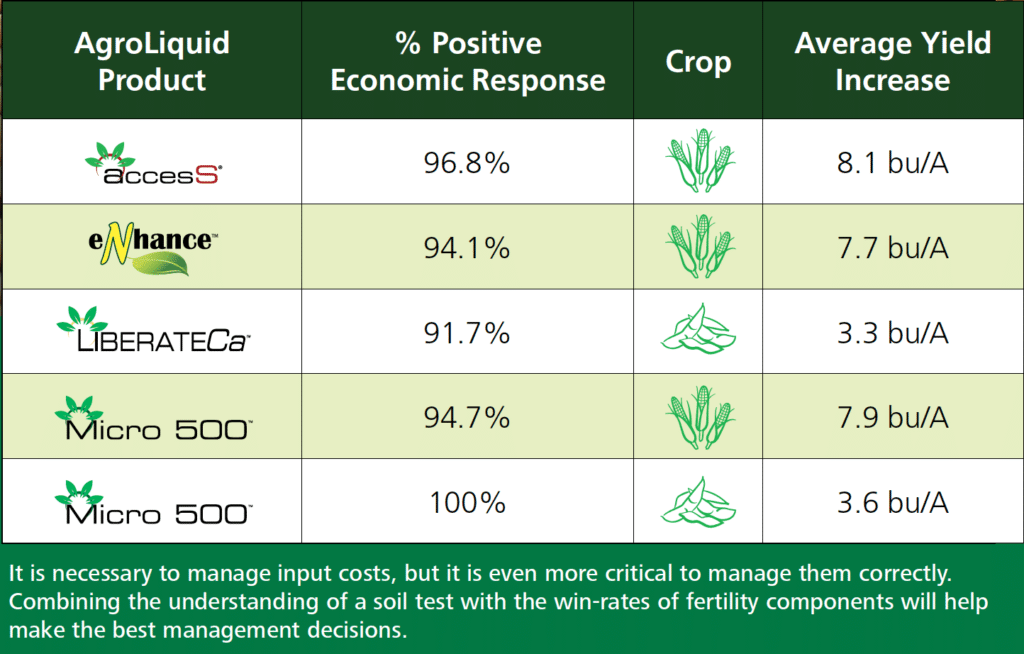The only consistency working in the agriculture industry is that every year is different. Looking toward the 2022 growing season this is already becoming apparent. Weather, commodity prices, input costs are all highly variable and mostly out of our control. However, there are some things we can control in managing a crop to reach the best yield potential while keeping economics in mind. Soil testing continues to be one of the most important tools a grower can use to help manage their crop fertility program. Although it is not simply just taking the soil test, but also understanding the results and knowing how to use them. The team at AgroLiquid can help growers understand soil test reports and walk through key areas where fertilizer dollars should be focused to balance yield and economics. This knowledge of soil fertility is backed by years of research from our North Central Research Station along with numerous field trials from across the country. Data is compiled to develop a win-rate, where measurements of both wins and losses are used to determine the likelihood of achieving a positive response from a fertility program. Then economics can be applied to help growers recognize the return a fertilizer investment has on profitability.
Cut With a Scalpel – Not A Machete
Sulfur
As input prices increase, the reaction often times is to cut out micro and secondary nutrients. However, these play a big part in yield so it is best not to cut completely. Sulfur is critical for corn production, as we have lost the “free sulfur” from the environment, adding to a fertility program is important. AgroLiquid had two sulfur products accesS® and eNhance™. AccesS is a 17% sulfur with micronutrients that should not be applied in-furrow, but can be applied away from the seed at planting, in strip-till, Y-Drop or sidedress. Win-rate analysis shows that over 96% of the time you will get a positive economic response for applications on corn with an average yield increase of around 8 bu/A. Another sulfur option is eNhance, an 8.7% sulfur with micronutrients, which is safe for in-furrow applications. Data shows that an average yield response from 2 qt of eNhance applied in-furrow on corn provides a 7.7 bu/A and an economic return 94.1% of the time.
Calcium
Calcium plays a key role in plant health and is especially important for soybean growth and development. There are many soils across the country that are low in calcium and soil amendments are the best way to address this. However, the addition of calcium in a fertility program will provide the necessary nutrients for the crop. LiberateCa is a seed safe calcium source, which can be safely mixed and applied with other AgroLiquid products. This allows a single product to be applied at planting. Win-rate analysis of adding LiberateCa to a soybean planter fertilizer program has shown over a 3 bu/A yield increase with a positive economic return nearly 92% of the time.
Micronutrients
With the push for higher yields, the benefit of micronutrients has become more apparent. However, many times the focus is on a single nutrient like zinc or boron. AgroLiquid’s Micro 500 is a specialized blend of five essential micronutrients: zinc, manganese, iron, copper and boron. Review of a soil test will help determine which micronutrients are low, but often the combination of these five micros will provide better yield response than just focusing on one nutrient. This is because they work better as a team and help improve the overall plant health. Micro 500 is a great product for any crop and can safely be applied at planting, foliar or any in-season application. When applied in-furrow on corn, average yield increase has been nearly 8 bu/A with an economic return 94.7% of the time. Applied to soybeans at planting, Micro 500 achieved 3.6 bu/A average yield increase with a positive return seen every time in this data set.


